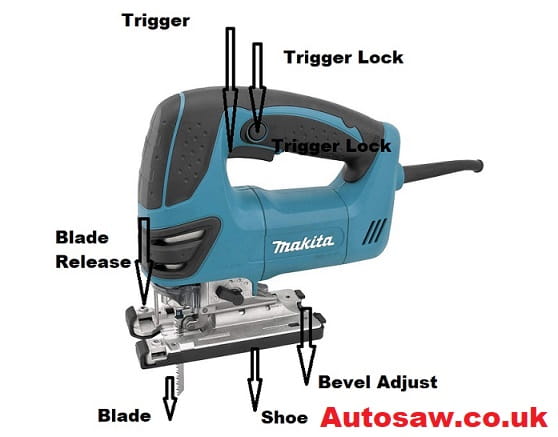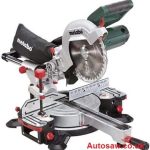As an Amazon Associate, I earn from qualifying purchases.

A jigsaw is a versatile hand tool that can be used to cut various types of materials, from wood to metal. It is a great tool for DIY projects and can be used for both straight and curved cuts. With the right blades and settings, you can easily make precise cuts with a jigsaw. In this article, we will look at how to use a jigsaw in order to get the best results. We will discuss the different types of blades available, how to set up the jigsaw correctly, and some safety tips when using this power tool.
Types of Jigsaws
Before using a jigsaw, it’s important to know the different types available in the market. There are three main types of jigsaws:
- Corded Jigsaw: This type of jigsaw is powered by an electric cord and offers consistent power supply. It’s ideal for heavy-duty work and can cut through thicker materials.
- Cordless Jigsaw: This type of jigsaw is battery-operated and offers better portability and flexibility. However, its power supply can be limited, and it’s best suited for light-duty work.
- Pneumatic Jigsaw: This type of jigsaw is powered by compressed air and offers better power and speed than corded or cordless jigsaws. It’s ideal for professional use and can cut through thicker materials.
Safety Tips
Using a jigsaw can be dangerous if proper safety precautions are not taken. Here are some tips to ensure safe jigsaw use:
- Always wear eye protection and a dust mask to protect yourself from flying debris and dust.
- Wear gloves to prevent injuries from sharp blades.
- Keep the jigsaw blade guard in place to prevent accidental contact with the blade.
- Make sure the blade is properly installed and tightened before use.
- Always unplug the jigsaw when changing the blade or making adjustments.
- Avoid cutting with the jigsaw above shoulder height to prevent losing control of the tool.
- Keep the work area clean and free from clutter to prevent tripping hazards.
Contents
How To Use a Jigsaw?
Choosing the Right Blade
Choosing the right blade for your jigsaw is crucial to achieving clean and accurate cuts. There are various types of blades available for different materials, including wood, metal, plastic, and tiles. Here are some tips for selecting the right blade:
- Choose a blade with the appropriate teeth per inch (TPI) for the material you’re cutting. A higher TPI blade is ideal for cutting thinner materials, while a lower TPI blade is better for thicker materials.
- For woodcutting, choose a blade with larger teeth and fewer TPI. For metal cutting, choose a blade with smaller teeth and more TPI.
- Use a diamond-grit blade for cutting tiles or other hard materials.
- Consider the blade’s width and thickness for making intricate cuts.
How to Use a Jigsaw on Wood
Jigsaws are most commonly used for cutting wood. Here’s how to use a jigsaw on wood:
- Mark the cutting line on the wood using a straight edge or a template.
- Insert the appropriate blade for woodcutting and tighten it securely.
- Turn on the jigsaw and align the blade with the cutting line.
- Hold the jigsaw with both hands and start cutting along the marked line.
- Move the jigsaw slowly and steadily, following the cutting line, and let the blade do the work.
- If you need to make a curved cut, turn the jigsaw in the direction of the curve while keeping the blade in contact with the wood.
- Once you’ve completed the cut, turn off the jigsaw and wait for the blade to stop spinning before setting it down.
How to Use a Jigsaw on Metal
Jigsaws can also be used for cutting metal, but it requires a different blade than woodcutting. Here’s how to use a jigsaw on metal:
- Mark the cutting line on the metal using a straight edge or a template.
- Insert the appropriate blade for metal cutting and tighten it securely.
- Turn on the jigsaw and align the blade with the cutting line.
- Hold the jigsaw with both hands and start cutting along the marked line.
- Move the jigsaw slowly and steadily, following the cutting line, and let the blade do the work.
- If you need to make a curved cut, turn the jigsaw in the direction of the curve while keeping the blade in contact with the metal.
- Once you’ve completed the cut, turn off the jigsaw and wait for the blade to stop spinning before setting it down.
How to Use a Jigsaw on Plastic
Jigsaws can also be used for cutting plastic, but it requires a different blade than wood or metal cutting. Here’s how to use a jigsaw on plastic:
- Mark the cutting line on the plastic using a straight edge or a template.
- Insert the appropriate blade for plastic cutting and tighten it securely.
- Turn on the jigsaw and align the blade with the cutting line.
- Hold the jigsaw with both hands and start cutting along the marked line.
- Move the jigsaw slowly and steadily, following the cutting line, and let the blade do the work.
- If you need to make a curved cut, turn the jigsaw in the direction of the curve while keeping the blade in contact with the plastic.
- Once you’ve completed the cut, turn off the jigsaw and wait for the blade to stop spinning before setting it down.
How to Use a Jigsaw on Tiles
Jigsaws can also be used for cutting tiles, but it requires a special diamond-grit blade. Here’s how to use a jigsaw on tiles:
- Mark the cutting line on the tile using a straight edge or a template.
- Insert the diamond-grit blade and tighten it securely.
- Turn on the jigsaw and align the blade with the cutting line.
- Hold the jigsaw with both hands and start cutting along the marked line.
- Move the jigsaw slowly and steadily, following the cutting line, and let the blade do the work.
- Once you’ve completed the cut, turn off the jigsaw and wait for the blade to stop spinning before setting it down.
How to Make a Straight Cut with a Jigsaw
Making a straight cut with a jigsaw requires proper alignment and steady hand movements. Here’s how to make a straight cut with a jigsaw:
- Mark the cutting line on the material using a straight edge or a template.
- Align the blade of the jigsaw with the cutting line.
- Hold the jigsaw with both hands and start cutting along the marked line.
- Move the jigsaw slowly and steadily, following the cutting line, and let the blade do the work.
- Keep the blade perpendicular to the material while cutting to ensure a straight cut.
How to Make a Curved Cut with a Jigsaw
Making a curved cut with a jigsaw requires the right blade and a steady hand. Here’s how to make a curved cut with a jigsaw:
- Mark the cutting line on the material using a template or by freehand drawing the curve.
- Insert the appropriate blade for the material you are cutting and tighten it securely.
- Turn on the jigsaw and align the blade with the starting point of the curve.
- Begin cutting along the curve, keeping the blade in contact with the material at all times.
- Move the jigsaw slowly and steadily, following the curve, and let the blade do the work.
- If the curve is tight, turn the jigsaw in the direction of the curve while keeping the blade in contact with the material.
- Continue cutting until the curve is complete.
How to Use a Jigsaw for Bevel Cuts
Bevel cuts are angled cuts made on the edge of a material. Jigsaws can make bevel cuts, but it requires adjusting the base plate of the jigsaw. Here’s how to use a jigsaw for bevel cuts:
- Loosen the screw on the base plate of the jigsaw.
- Tilt the base plate to the desired angle.
- Tighten the screw to lock the base plate in place.
- Mark the cutting line on the material.
- Align the blade of the jigsaw with the cutting line.
- Hold the jigsaw with both hands and start cutting along the marked line.
- Move the jigsaw slowly and steadily, following the cutting line, and let the blade do the work.
How to Use a Jigsaw with Guide Rails
Guide rails are accessories that can help make straight cuts with a jigsaw. Here’s how to use a jigsaw with guide rails:
- Attach the guide rail to the material using clamps or adhesive.
- Adjust the guide rail to the desired cutting line.
- Align the blade of the jigsaw with the starting point of the cutting line.
- Turn on the jigsaw and start cutting along the guide rail.
- Move the jigsaw slowly and steadily, following the guide rail, and let the blade do the work.
How to Maintain Your Jigsaw
Proper maintenance of your jigsaw can help prolong its lifespan and ensure optimal performance. Here are some tips on how to maintain your jigsaw:
- Regularly clean the base plate and blade of the jigsaw with a dry cloth.
- Lubricate the blade with a lubricant spray to prevent rust and improve cutting performance.
- Check the blade regularly for damage or signs of wear and replace it if necessary.
- Store the jigsaw in a dry and cool place, away from moisture and direct sunlight.
- Follow the manufacturer’s instructions for maintenance and cleaning.
FAQs
- Can a jigsaw cut through thick materials? Yes, a jigsaw can cut through thick materials such as wood and metal, but it requires the appropriate blade and proper technique.
- Is it necessary to wear safety gear when using a jigsaw? Yes, it is essential to wear safety gear such as goggles and ear protection when using a jigsaw to protect yourself from debris and noise.
- How do I choose the right blade for my jigsaw? Choose the blade according to the material you are cutting and the type of cut you want to make. Consult the manufacturer’s instructions or seek advice from a professional if you are unsure.
- Can a jigsaw make straight cuts? Yes, a jigsaw can make straight cuts, especially when used with a guide rail or straight edge.
- What is the difference between a jigsaw and a reciprocating saw? A jigsaw is a handheld power tool that uses a reciprocating blade to make cuts in materials, while a reciprocating saw is a larger power tool that is typically used for demolition work and cutting through thick materials like metal and concrete.
Conclusion
By following the steps outlined above, you should now have a better understanding of how to use a jigsaw safely and effectively. From setting up your workspace to choosing the right blade for your project, there are many things to consider when using this tool. By taking the time to understand these factors, you can ensure that your projects are completed quickly and safely – without any unexpected surprises!





